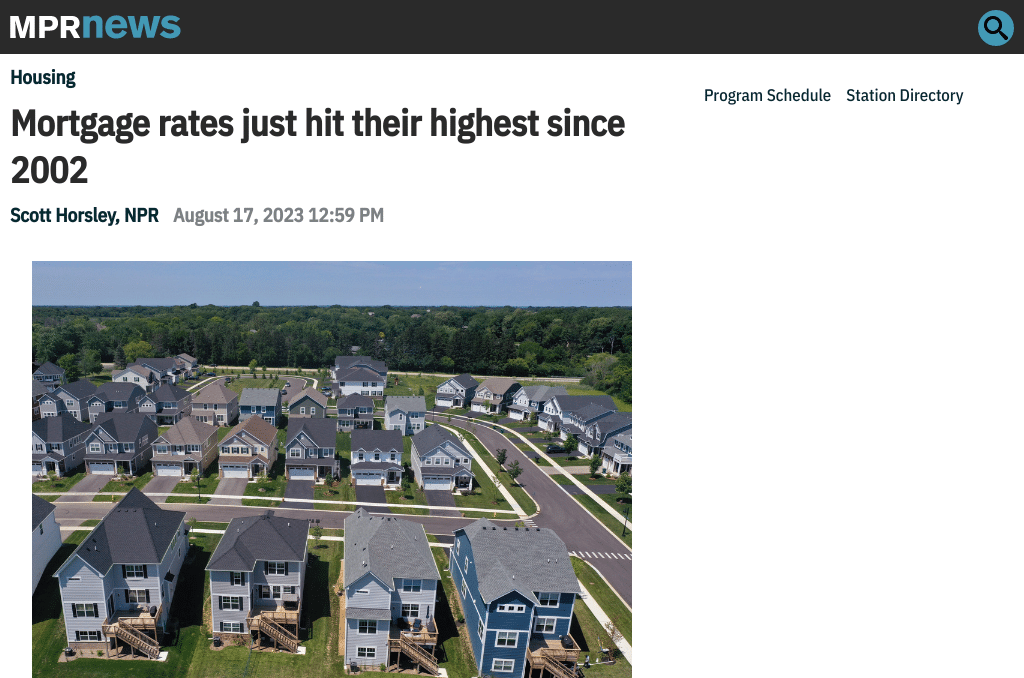The average rate on a 30-year fixed mortgage reached a staggering 7.09% on Thursday, according to Freddie Mac, a government-sponsored home-loan agency. This rate is the highest in more than two decades, with only two instances of higher rates in the last 20 years, recorded at 7.08% in October and November.[0] The current rate of 6.96% is significantly higher than the 5.51% rate from a year ago and the pre-pandemic average of 3.9%.[1] These soaring mortgage rates have made homeownership even less affordable for many prospective buyers.[2]
The average 30-year fixed mortgage rate has remained above 6.5% since May, with a peak of 7.08% in November. These increases in rates are a result of multiple rate hikes by the Federal Reserve, aimed at lowering inflation.[3] Mortgage rates tend to follow the federal funds rate set by the Fed, and as the central bank raised interest rates at its fastest pace in decades, mortgage rates spiked from about 3% to over 6% within a six-month period last year.[4] However, it is important to note that current mortgage rates are still significantly lower than the rates seen in the 1980s, which peaked at more than 18%.[4]
While the rate hikes led by Fed Chairman Jerome Powell have not yet resulted in severe economic conditions, several indicators suggest a potential recession on the horizon.[4] The difference in yields for short and long-term bonds, which is a proxy for investor confidence in the economy over the short-term, predicts a roughly two-thirds chance of a recession occurring within the next year.[4] Additionally, the yield for 10-year U.S.-issued bonds surged to its highest level since 2008, further indicating a breakdown in faith in the economy.[4]
These rising mortgage rates have had a significant impact on the housing market.[5] Home prices have become considerably more expensive, with the median home in the U.S. selling for $422,137 last month compared to $318,100 a year ago.[4] The monthly payment on a $350,000 house, assuming a 20% down payment, would now be $1,880, compared to $1,159 in 2021 when interest rates were below 3%.[2] As a result, many Americans are finding it increasingly difficult to afford new homes, and existing homeowners are hesitant to sell and give up their lower mortgage rates.
The high rates have slowed demand in the housing market, but the primary cause of the stalled market is a lack of supply.[6] Low inventory remains a significant issue, as homeowners are reluctant to sell their homes and potential buyers face limited options. This combination of higher mortgage rates and low inventory has made it challenging for both first-time buyers and current homeowners looking to upgrade.
The future of mortgage rates remains uncertain. If inflation continues to decline and the Fed is able to hold rates steady or even cut them in 2024, mortgage rates may see some relief.[7] However, a return to the 2% to 3% range is unlikely.[8] The Fed's aggressive rate hikes could potentially push mortgage rates to 8% if they decide to raise interest rates again in the near future.[7] The National Association of Home Builders/Wells Fargo Housing Market Index also fell to its lowest level in three months, indicating a decline in builder sentiment.[9]
Overall, the current state of mortgage rates and the housing market highlights the challenges faced by prospective buyers and existing homeowners. Affordability has become a significant concern, and the lack of supply is exacerbating the issue. As the economy continues to evolve, it remains to be seen how mortgage rates will fluctuate and how the housing market will respond.
0. “U.S. mortgage interest rates soar past 7%, again” cleveland.com, 17 Aug. 2023, https://www.cleveland.com/news/2023/08/us-mortgage-interest-rates-soar-past-7-again.html
1. “Homebuilder sentiment plummets as mortgage rates surge again” Fox Business, 15 Aug. 2023, https://www.foxbusiness.com/economy/homebuilder-sentiment-plummets-mortgage-rates-surge-again
2. “Mortgage rates just hit their highest since 2002” MPR News, 17 Aug. 2023, https://www.mprnews.org/story/2023/08/17/npr-mortgages-housing-homes-freddy-mac-economy-interest-rates
3. “U.S. mortgage rates jump to 7.09%, highest since 2002” Crain's Chicago Business, 17 Aug. 2023, https://www.chicagobusiness.com/residential-real-estate/us-mortgage-rates-jump-709-highest-2002
4. “Mortgage Rates Are Surging At Their Fastest Pace On Record—Here's What That Could Mean” Forbes, 17 Aug. 2023, https://www.forbes.com/sites/dereksaul/2023/08/17/mortgage-rates-are-surging-at-their-fastest-pace-on-record-heres-what-that-could-mean/
5. “30-year fixed-rate mortgages hit two-decade high” Axios, 17 Aug. 2023, https://www.axios.com/2023/08/17/mortgage-rates-30-year-fixed
6. “Mortgage rates surge to 21-year high” KABC-TV, 17 Aug. 2023, https://abc7.com/mortgage-rates-surge-to-21-year-high/13663655/
7. “US mortgages could hit 8% says Realtor economist” ForexLive, 16 Aug. 2023, https://www.forexlive.com/news/us-mortgages-could-hit-8-says-realtor-economist-20230816
8. “Mortgage Refinance Rates for Aug. 17, 2023: Rates Tick Higher” CNET, 17 Aug. 2023, https://www.cnet.com/personal-finance/mortgages/mortgage-refinance-rates-for-august-17-2023-rates-tick-higher/
9. “Housing Market Outlook: Builder Confidence Drops for First Time in 2023” Markets Insider, 15 Aug. 2023, https://markets.businessinsider.com/news/stocks/housing-market-outlook-mortgage-rates-builder-confidence-prices-affordability-rates-2023-8


